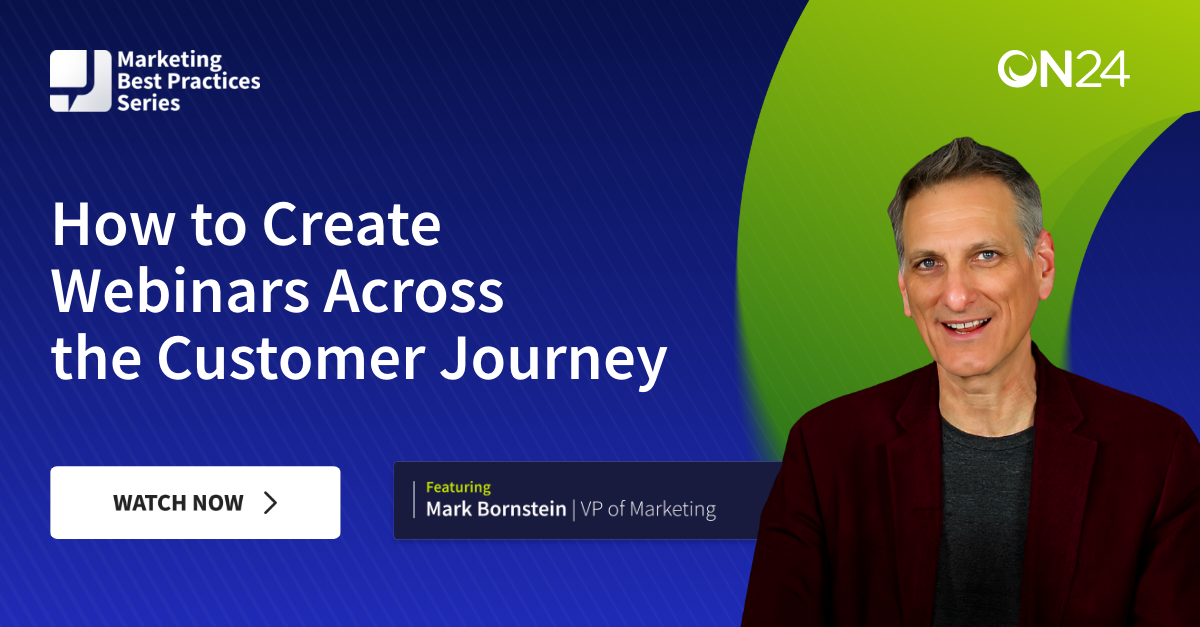Today, effectively generating pipeline and increasing revenue requires digital marketers to meet prospects and customers where they are. They do so by providing precisely what potential customers need, and when they need it, through highly customized and targeted approaches.
This means digital marketers need to reinvent their approach to the B2B customer journey and develop cohesive, full-funnel strategies for engagement.
Fortunately, webinars, virtual events and content hubs provide marketers with excellent opportunities to engage audiences at every stage of the buying journey — from awareness to advocacy.
Here’s how.
What is the B2B customer journey and how has it changed?

The B2B customer journey is a marketing concept that divides purchase decisions into different stages. Traditionally, the customer journey encompasses five main stages:
- Brand awareness
-
- This is the stage where brands typically establish themselves as having the solution—or product—that fulfills the customer’s need.
2. Consideration
-
- Here, the brand proves itself to the customer, identifying why it is a good pick and the perfect provider for the prospect’s needs and wants.
3. Decision
-
- This stage is when the prospect decides to go along with the brand. A great way to encourage customers to do this is to include a “book a demo” button on digital content, such as a webinar or offer them the opportunity to speak to a salesperson.
4. Retention
-
- This segment focuses on building customer loyalty and retaining accounts you already have. Providing help when needed, offering to upsell opportunities, or even encouraging the customer to renew their membership or contract are all standard ways a brand can sustain and increase its retention.
5. Advocacy
-
- Consider this the “reward” stage for customer loyalty. Advocacy is a way for brands to interact with customers, asking them to provide testimonials and referrals. Meanwhile, brands can publicly celebrate customer success with anything from reciprocal advocacy, social posts, gift basket and more.
Ultimately, there is no “right” customer journey. In today’s digital-first world, prospects can enter the buying funnel at any stage and quickly go from brand awareness to decision or from advocacy to consideration.
That means that brands must have strong strategies for each part of the funnel.
What is the B2B customer journey?

The B2B customer journey is just the customer journey theory in a business-to-business context. Specifically, it seeks to plot out an account’s varying steps to convert.
For B2B marketers, this map can be as detailed as they want. For example, a customer journey map can include elements like which marketing channels you’ll use to communicate with your audience (and at what stage) to assigning internal marketing teams to specific steps in the journey. You can (and should) map out which KPIs you’ll monitor at each stage.
However, having a detailed, well-thought-out map is not always necessary. What’s important is aligning your customer journey to your key objectives. These key objectives would obviously include conversion and increasing your ROI, but they might also include putting your brand on the map and becoming recognized within your industry sphere.
What has changed?
In the past, B2B marketers understood the customer journey as a simple, sequential funnel where prospects enter one end and customers exit the other. In other words, prospects would start out at the awareness stage and emerge as loyal customers once they complete each stage.
This linear journey is an old way of thinking. Digital experiences, including webinars, have drastically changed how prospects and customers engage with a brand and, consequently, convert.
For example, a prospect may engage with and promote a brand evangelist well before even considering a purchase from the brand itself. Brands need to accommodate this change in the buying journey by empowering audiences to explore and experience a brand on their own terms.
So, how can brands do that? The answer lies in building a network of engaging digital experiences that educate prospects and customers on their terms in their preferred mediums. That’s why virtual events and content hubs can easily meet customers wherever they are on their B2B customer journey.
How digital marketers can accommodate the customer journey today
To accommodate today’s diverse B2B customer journeys, digital marketers must invest in the channels where they know their customers consume content.
Here are some key steps that marketers can take to make the most out of their investments:
-
- Establish buyer/customer personas:
- A buyer, or customer, persona is simply a description of the target customer a brand is looking to connect with. Developing a persona should be completed early since it can point marketers in the right direction and naturally unfold the rest of their strategy.
- Establish buyer/customer personas:
-
- Collect data on the most popular channels and topics:
- Knowing where your customer “hangs out” is important. Are they on social media; if so, what kind? Answering these questions can determine the format of your content.
- Collect data on the most popular channels and topics:
-
- Collect and analyze engagement data:
- Find out what content your customers are engaging with. This can help you decide what content you have that may or may not be working. Is it time to create new material or label high-performing pieces as ‘evergreen’?
- Collect and analyze engagement data:
-
- Use engagement data to understand where an account is in the customer journey:
- Knowing where an account is within the funnel can help determine what additional information they may need so that you can provide better offers and experiences. For example, if they are still between the consideration and decision stages, you can tailor and deliver content specifically for their stage, encouraging them to book a demo that shows how a product works in more detail.
- Use engagement data to understand where an account is in the customer journey:
How to build engaging B2B customer journey experiences

An engaging B2B customer journey starts with planning. First, you’ll need to understand the content and experiences that connect with every stage and persona. You’ll also need to map out different touchpoints that empower audiences to enter or pivot to a new stage in their journey. Finally, you should have a strategic plan to drive as much engagement as possible.
Let’s dive into it.
Start with B2B customer journey mapping
Mapping the customer journey can help you determine what content is needed and for which funnel stage. A content hub is a perfect way for users to access your content on their own terms.
Think of this content hub as a menu that prospects and customers can choose from — a buffet of content, including webinars and experiences that meet the appetite for every stage of the funnel (top, mid, bottom) and for every audience type (decision maker, tactical doer, etc.).
When you can, try using your existing content—a lot of it will be relevant. There’s no need to recreate the wheel; it’s just a matter of positioning your content in the right place.
Create customer touchpoints
Here, you can connect with every role, use case, and industry that is part of your target customer/buyer profile. Ask yourself questions like:
-
- Where are they going to see this content? Across which channels and experiences?
- Depending on where you think your touchpoint will live can determine the content itself. Will it be a full-length webinar or simply a webinar excerpt? It might be a CTA button leading to a registration page or a full-length blog piece that speaks to the webinar topic in a different format.
- Where are they going to see this content? Across which channels and experiences?
-
- Where can you present offers to move them to the next stage, no matter where they are on their journey?
- Have relevant content steps for each stage in the funnel. For example, including content where the customer can learn more about your business and product is equally important as content that encourages them to sign up for a demo or see what other customers are saying.
- Where can you present offers to move them to the next stage, no matter where they are on their journey?
Provide engaging customer journeys
Enabling customers to move to the next experience in any direction within the customer journey (up, sideways, or down) is a way for you to meet them where they are.
Here are some questions to ask yourself when it comes to determining where next to point your customer:
-
- What content can I link out to or encourage them to check out?
- How can I make them want to interact and engage with the brand even after this experience?
- Are there offerings to satisfy every version of my brand’s buying persona?
Regardless of where you might steer them next, don’t simply offer just one conversion touchpoint or CTA like “Book a meeting” or “Sign up for a free trial.” Those options are great, but they may not meet everyone where they are.
At best, you’ll most likely end up with false positives — people you think are ready to buy or trade up but are nowhere near ready to do so. At the worst, you’ll annoy your audience — leading them to go elsewhere.
Ensure quality leads and a seamless user experience by including multiple avenues and content for your customers to explore.
Optimize your B2B customer journey with webinars

Work smarter, not harder. With webinars and similar digital content, you can quickly and easily create holistic customer journeys — especially when you incorporate the power of generative artificial intelligence in your marketing strategy.
Let’s take a look at how.
Personalize for different customer journey segments
Our CTAs, offers, resources, and more can all be tailored to the most important segments of your audience. And for those not in a segment — no problem! They will also see an offer that they may want to choose.
Map customer personas based on engagement data
Using AI-generated heat maps can help your brand understand which parts of the webinar resonated most for each viewer segment based on their engagement and behavior. You can use this information for follow-up content and to improve future experiences.
You can also use this information to tailor your customer persona. For example, suppose many viewers were engaged around a particular part of the webinar that explored how to solve a unique problem. In that case, you know this information may be key to many of your customers. These insights are a great way to either bolster your confidence in your existing persona or tweak your persona to meet what you learned from your data.
Repurpose webinars into new content
The hard work put into one format of content or experience shouldn’t sit in isolation. An artificial intelligence marketing plan can help you repurpose a webinar into new assets to maintain engagement going forward. For example, use the data analytics to pull out specific parts of a webinar and recreate it into either smaller, snackable bits that live on social media, or into longer-forms like blog posts, e-books and reports.
Create your B2B customer journey today

With the ON24 Intelligent Engagement Platform, you can create amazing, interactive digital experiences that speak to audiences when and where they’re ready to be engaged.
Sign up for a demo of ON24 today to learn how to use webinars to interact with your audiences, create content and provide your prospects with a highly personalized customer journey — not to mention accelerate pipeline for your organization. Click here to get started.


